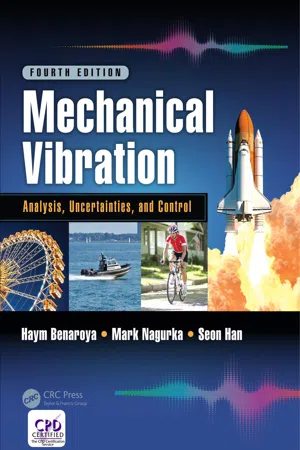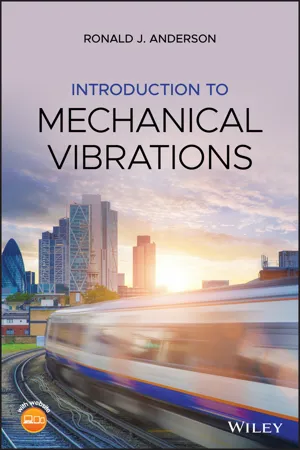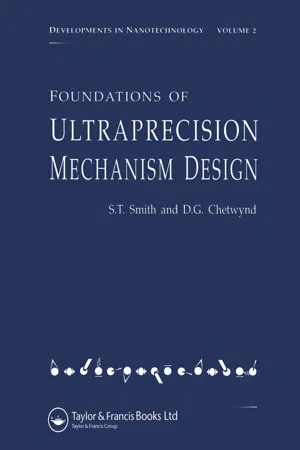Damping
Damping refers to the process of reducing or controlling the magnitude of oscillations, vibrations, or movements in a system. It is commonly achieved by dissipating the energy of the oscillations through various means such as friction, fluid resistance, or electrical resistance. Damping is crucial in engineering to enhance stability, reduce wear and tear, and improve the performance of mechanical and structural systems.
4 Key excerpts on "Damping"
- eBook - ePub
Mechanical Vibration
Analysis, Uncertainties, and Control, Fourth Edition
- Haym Benaroya, Mark Nagurka, Seon Han(Authors)
- 2017(Publication Date)
- CRC Press(Publisher)
...There is always energy dissipation in any real system. We sometimes ignore Damping in order to study idealized (undamped) systems because they exhibit key oscillatory characteristics that are useful to our fundamental understanding. Damping mechanisms are not as well understood as are other aspects of vibratory systems. There is no universal model for Damping. “There are excellent reasons why the stiffness and inertia properties of a general discrete system, executing small vibration around a position of stable equilibrium, may be approximated via the familiar stiffness and mass matrices. These simply represent the first non-trivial terms which do not vanish when the potential and kinetic energy functions are Taylor-expanded for small amplitudes of motion. Nothing so simple can be done to represent Damping, because it is not in general clear which state variables the Damping forces will depend on.” 4 Damping mechanisms involving structures can be perform into three types: (1) material Damping where energy is dissipated within the body, (2) boundary Damping where dissipation occurs at junctures between elements of a structure, and (3) viscous Damping due to contact between a structure and a fluid environment where energy is dissipated into the fluid. Damping is further subdivided in the next section. Viscous dampling do mommonly used in mechanical vibration and in this book. Material Damping is induced by microstructural strains and relative motion, in particular, due to imperfections in the atomic lattice structure of the material. This discrete reality is usually represented by a viscoelastic continuum model in applications. Viscoelastic models are discussed in Appendix B. Less well defined is boundary Damping. Built‐up structures are comprised of hundreds to many thousands of parts that are welded, riveted, glued, or fastened in other ways. At these interfaces significant friction forces develop as a result of oscillation and differential movements...
- eBook - ePub
- Ronald J. Anderson(Author)
- 2020(Publication Date)
- Wiley(Publisher)
...6 Damping Damping involves the removal of energy from vibrating systems. There are many mechanisms that provide Damping and no system is immune from them. Friction, air resistance, and the propensity for deformed materials to generate internal heat all take energy out of the system and provide Damping. 6.1 Linear Viscous Damping The classic model of a Damping element is one in which the force generated is proportional to the rate of change of length of the element. The rate of change of length is the relative velocity across the damper. “Proportional” implies linearity and a force proportional to speed implies laminar, viscous flow. As a result, these elements are often referred to as “linear viscous dampers” or simply “viscous dampers”. These elements were previously defined in Section 1.2.4 where Rayleigh's dissipation function was introduced and some of that material is repeated here. Figure 6.1 shows a system where a body is attached to ground by a damper. The body is moving to the right with speed and the Damping coefficient (constant of proportionality) is. The physical connection of the damper to both the ground and the body dictates that the rate of change of length of the damper is equal to the speed. The force in the damper will therefore be. The direction of the force will be such that it causes the damper to increase in length as shown in the lower part of Figure 6.1. By Newton's 3rd Law, the force on the body must be equal and opposite to the force acting on the damper. The force therefore acts to the left on the body. In other words, the Damping force opposes the velocity of the body. We will be categorizing Damping by the amount of energy removed per cycle of motion. We can calculate that value analytically for the linear viscous damper...
- eBook - ePub
Theory of Nonlinear Structural Analysis
The Force Analogy Method for Earthquake Engineering
- Gang Li, Kevin Wong(Authors)
- 2014(Publication Date)
- Wiley(Publisher)
...9 Application: Structural Vibration Control The structural vibration control began in mechanical engineering in the early 20th century, and subsequently developed in civil engineering. At present, the structural vibration control technique is verified as an effective way to reduce responses of structures under natural hazards such as earthquakes and strong winds. Over the past few years, a number of structural control techniques have been developed and applied in practice, specifically in seismic regions. Structural control systems, in general, fall into four categories: passive, active, semi-active and hybrid control based on whether the power source is necessary. For the active and semi-active control technique, the control force is often determined by control strategies, but the passive control technique is through energy-dissipation devices to dissipate the input energy. In this chapter, the FAM is used to simulate the seismic dynamical analysis of structures with passive and active controlling devices. 9.1 Passive Control Technique The passive control technique is through leading the input energy from environmental loads to special elements or devices to reduce energy-dissipating demand on primary structural members and minimize possible structural damage. These special elements or devices are so-called passive energy dissipation devices (PEDD) due to their energy-dissipation capacity. 9.1.1 Model of Passive Energy-Dissipation Devices The PEDDs are mainly categorized into velocity-dependent dampers and displacement-dependent dampers. (1) Velocity-dependent PEDDs Viscous and viscoelastic dampers are two typical kinds of velocity-dependent PEDDs. The restoring force of the dampers is associated with the inter-story velocity...
- eBook - ePub
- Stuart T. Smith(Author)
- 2017(Publication Date)
- CRC Press(Publisher)
...If a hollow section is filled with particulates, they will slide over each other upon the application of small forces. Typically an extruded metal optical bench would be filled with sand to ‘dull’ its response, and, incidentally, to increase its mass. The dissipation is again provided by Coulomb frictional forces. The forces required to induce interface shear are much smaller that in solids because of the low inertial mass of the individual particles. It is not clear whether there is a minimum amplitude for their effectiveness. Stand-alone dampers, that is dissipating mechanisms, are effective for many conventional applications, but may require more relative motion than can be tolerated in our context. Magnetic Damping, for example through eddy-currents, tends to fall in this category. Magnetoelastic materials (see also Section 7.1.6) provide a single material equivalent that may be better at small amplitudes. Strain results in their magnetic domains being irreversibly distorted, causing a net energy loss that provides mechanical Damping. Nivco (72% Ni, 23% Cr) is of particular interest. It has a loss coefficient that increases linearly with applied stress, is significantly higher than almost all metals at low amplitude and, for the majority of engineering applications, can be considered independent of frequency, Harris and Crede, 1961. A more common type of damper uses the relative motion between two mechanism elements to pump a fluid through an orifice. Viscous drag produces a Damping characteristic that can be adequately modelled by a classical linear force-velocity relationship. Both gases and liquids are used in this type of device. Since gasses are compressible, they may be used as both damper and support spring, see Section 10.5.2. Oil, or other liquid, dampers often offer the cheapest method of energy dissipation but they must be used in conjunction with springs...



